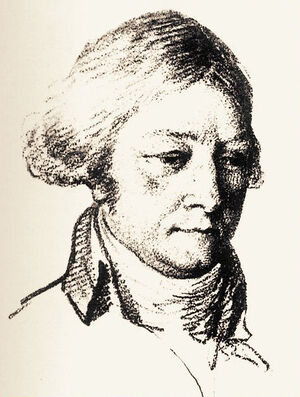Pierre-Alexandre-Laurent Forfait (nonfiction)
Pierre-Alexandre-Laurent Forfait (21 April 1752, Rouen – 8 November 1807, Rouen) was a French engineer, hydrographer and politician, and Minister of the Navy.
Born to a family of rich merchants, Forfait studied at a Jesuit college in Rouen, where he was awarded prizes in Mathematics and Hydrography upon graduation. In 1773, and in spite being a Commoner, he was admitted as an assistant member of Rouen Academy and assistant naval engineer, before serving at Brest harbor.
In 1777, Forfait rose to sub-engineer under Antoine Groignard. In 1781, he was made an adjunct member of the Naval Academy. In 1783, he embarked on the 110-gun Terrible, part of a Franco-Spanish fleet assembled before Cádiz under Admiral d'Estaing, but the end of the American War of Independence occurred before it saw action. Forfait nevertheless helped repair eleven of the ships of the fleet.
After the Treaty of Paris, he returned to work at the Naval Academy and notably authored a Traité de la mâture upon request of Castries, then Secretary of State of the Navy. In recognition, he was admitted as a corresponding member in the Academy of Sciences. He simultaneously developed new techniques to improve the disposition of cargo in ships' holds.
In 1789, he was appointed director of service of Le Havre harbour, where he improved the design of fluyts. He was then sent to England to study the British shipbulding techniques, and authored the Observations sur la marine de d'Angleterre upon his return.
After the outbreak of the French Revolution, Forfait was elected at the Legislative Assembly in 1791 as deputy for the Seine-Inférieure. His moderate positions earned him the mocking nickname of Juste Milieu, which he wore with pride. At the end of his mandate in September 1792, he returned to shipbuilding at Le Havre.
Around this time, Forfait designed the 38-gun frigate Seine, which included structural innovations and were designed to carry 24-pounder long guns — more powerful than the usual 18-pounder long guns usually born by ships of this size, although the Seine was eventually armed with 18-pounders. The Seine class, built on these plans, came to comprise 7 ships. Forfait furthered his efforts with the Romaine class in 1794, and was also involved in the design of the Etna-class corvettes.
During the Reign of Terror, he was accused at a political club of Le Havre. He was eventually freed by the Committee of Public Safety and made general inspector for forests. In 1794, he was tasked to design specialised ships to navigate the Seine river; he consequently design a lugger, the Saumon, and authored Mémoire sur la navigation de la Seine.
In 1797, the Directory tasked him, along with Rosily-Mesros and David, to study the possibility to establish a military harbor in Antwerp; these studies were followed by the construction of an arsenal. He was then sent to the recently captured Venice, where he oversaw the launch of ships under construction in her harbor and appropriated by the French in the Campaign of Italy; in August 1797, these frigates were launched as Muiron and Carrère.
Tasked with the naval preparations of the French campaign in Egypt and Syria, Forfait prepared 15 ships of the line, 14 frigates, 72 lesser warships and 400 transports in Toulon, Genoa, Ajaccio and Civitavecchia. He then returned to Le Havre, where he designed 3 heavily armed gunboats to repel British bomb vessels.
After the 18 Brumaire, Forfait became Napoleon Bonaparte's first Minister of the Navy, office which he held from November 1799 until his resignation on 1 October 1801, while simultaneously designing ships of the Navy and plans for Boulogne harbor. At the collapse of the Peace of Amiens and the outbreak of the War of the Third Coalition in May 1803, Forfait was tasked with improving the Flottille de Boulogne.
In 1805, Forfait was sent to Genoa as Maritime Prefect, tasked to establish a naval presence there. He managed to successfully launch the 74-gun Génois, whose originally intended launch had been botched by her constructors, leaving the ship damaged and stuck on her railing. He nevertheless fell in disfavor after the affair.
Forfait retired in Rouen, where he died on 8 November 1807.
In the News
Fiction cross-reference
Nonfiction cross-reference
External links:
- Pierre-Alexandre-Laurent Forfait @ Wikipedia
Attribution:

